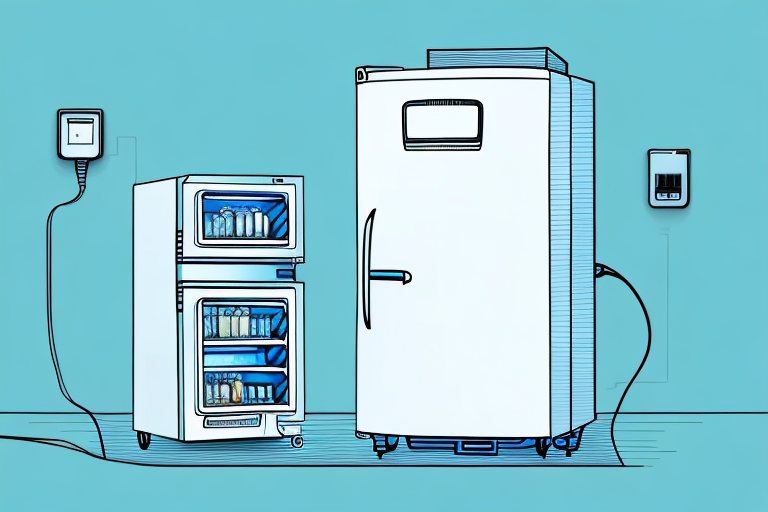How Long Should You Wait to Plug in Your Fridge After Moving?

Moving to a new place? Among the many things to do when you move, one crucial task is to move your refrigerator to your new home. However, once you get your fridge to your new place, do you immediately plug it in or wait for a specific amount of time? In this article, we’ll take a closer look at how long you should wait to plug in your fridge after moving, the factors affecting the waiting time, and provide general guidelines and tips for moving different types of fridges.
Understanding the Importance of Waiting
Plugging in your fridge immediately after moving it can lead to several issues that can affect the longevity of your appliance. Waiting before you plug it in is essential because it allows time for essential components in the fridge, such as the compressor and coolant, to settle back into their correct positions. This way, you protect the compressor, ensure proper functioning, and prevent potential damage to your refrigerator.
Protecting the Compressor
The compressor is the most crucial component in any fridge. It’s responsible for circulating the refrigerant and keeping the fridge cold. When you move your fridge, the compressor oil shifts from its original position and settles at the bottom of the unit. Plugging in and turning on the fridge immediately can cause the compressor to run dry, leading to damage. Waiting gives the oil enough time to settle, ensuring proper lubrication and protecting the compressor from damage.
Additionally, waiting allows the compressor to settle into its correct position. Moving the fridge can cause the compressor to shift, which can affect its performance. Waiting before plugging in the fridge gives the compressor time to settle back into its correct position, ensuring optimal performance and longevity.
Ensuring Proper Functioning
When you plug your fridge in after moving it, the coolant needs to circulate through the entire system to ensure the fridge’s proper functioning. Turning the fridge on too soon can lead to a coolant rush, which can cause problems like leaks or blockages. This can damage the fridge, and you may need to pay for expensive repairs.
Waiting allows the coolant to settle back into its correct position and ensures that there are no leaks or blockages. This way, when you do eventually plug in the fridge, it will function correctly, and you won’t have to worry about any issues.
Preventing Potential Damage
Electrical shock is another risk you face if you plug your fridge in immediately after moving it. During transit, some components may have shifted or come loose. Waiting before you plug in the fridge gives you a window to inspect it for any signs of damage. You can also fix any issues before you plug it in, preventing further damage.
Waiting also allows you to clean the fridge thoroughly before plugging it in. Moving can cause dust and debris to accumulate in the fridge, which can affect its performance. Taking the time to clean the fridge before plugging it in ensures that it will function correctly and prevent any potential damage.
In conclusion, waiting before plugging in your fridge after moving it is essential. It protects the compressor, ensures proper functioning, and prevents potential damage. By taking the time to wait, you can ensure that your fridge will last for years to come.
Factors Affecting the Waiting Time
The amount of time you need to wait after you move your fridge depends on several factors:
The Type of Refrigerator
The type of refrigerator you have determines how long you should wait before plugging it in. A fridge with a standard compressor typically needs four hours before you plug it in. However, side-by-side or French door fridges that have dual evaporators or more zones may need 24 hours or more to settle.
If you have a standard compressor fridge, you may wonder why you need to wait four hours before plugging it in. The answer is simple. Compressors work by compressing refrigerant gas, which then cools and condenses into a liquid. During transportation, the compressor may have been tilted, causing the oil to mix with the refrigerant. Waiting for four hours allows the oil to settle back to its proper place, ensuring that the compressor works correctly.
On the other hand, side-by-side or French door fridges with dual evaporators or more zones have more complex cooling systems. These fridges have separate cooling systems for the freezer and the fridge compartments, which require more time to settle after transportation. Waiting for 24 hours or more ensures that the fridge works correctly and that the temperature is consistent throughout.
The Duration of the Move
The farther you move your fridge, the longer you need to wait before plugging it in. If you’re moving locally, waiting for four hours is usually enough. However, suppose you’re moving across the country. In that case, you may need to wait for up to 24 hours or longer to ensure your appliance works correctly.
When you move your fridge, the compressor and coolant may have been jostled around, causing air bubbles to form in the coolant lines. Waiting allows these bubbles to dissipate, ensuring that the fridge cools correctly.
The Position of the Fridge During Transit
If you moved your fridge in an upright position, you may need less time to wait before plugging it in. However, if you transported it sideways or lying down, you may need to wait for longer. This is because the coolant and compressor oil flow differently in these positions, and waiting allows them to adjust to their proper positions.
When you move your fridge in an upright position, the coolant and compressor oil settle at the bottom of the fridge, where they belong. However, if you transport your fridge sideways or lying down, the coolant and oil may settle in different areas, causing the compressor to work harder than it should. Waiting for a longer period allows the coolant and oil to settle back to their proper positions, ensuring that the fridge works correctly.
General Guidelines for Different Fridge Types
There are several types of fridges available in the market, and each requires specific guidelines before you plug them back in after moving. Here are some general guidelines to follow for different types of fridges:
Standard Compressor Fridges
For standard compressor fridges, wait for four hours before plugging it in and turning it on. This is enough time for everything to settle back into place, allowing your fridge to function correctly.
Built-in Refrigerators
Built-in refrigerators usually need more time to settle after moving. Allow them to rest for about 24 hours before plugging them in to ensure proper working and to avoid any damage to the appliance.
Side-by-Side and French Door Models
These models contain multiple evaporators and zones, making them more complicated than standard fridges. As such, wait for at least 24 hours or more before plugging them in to avoid any damage to the appliance.
Tips for Moving Your Fridge Safely
Moving your fridge can be challenging, but you can make it easier and safer by following these tips:
Preparing Your Fridge for the Move
Unplug your fridge, defrost it and clean it before moving it. If you’re traveling far, remove any movable parts, such as shelves and drawers, and wrap them in bubble wrap or blankets. This prevents scratches and breakage.
Securing the Fridge in the Moving Truck
Use sturdy moving straps to secure the fridge in the truck, ensuring it can’t shift or tip over during transit. Place it upright in the truck, securing it with ropes or straps. This reduces the risk of moving parts coming loose or the fridge getting damaged in the truck.
Properly Unpacking and Positioning Your Fridge
When you get to your new location, unwrap the fridge and let it settle for the recommended time before plugging it in. Once it’s time, place it in a leveled position to avoid compromising the compressor. Also, ensure there’s enough space around the fridge to encourage proper airflow and prevent airflow blockages.
Conclusion
Moving your fridge can be both exciting and daunting, but with the tips and guidelines discussed in this article, you can move your appliance without compromising its functionality. Remember, waiting before you plug in your fridge after moving is essential to protect the compressor, ensure proper functioning, and prevent potential damage. Follow the given instructions for different fridge types, and you’ll save yourself from headaches and costly repairs in the long run.



